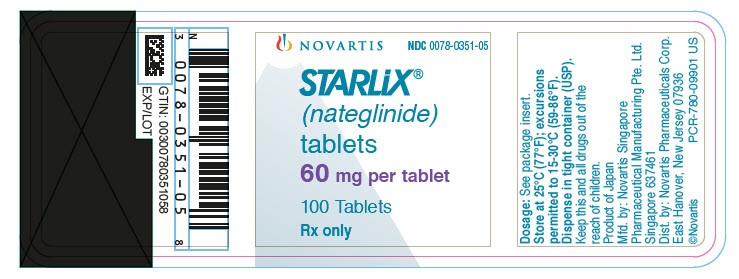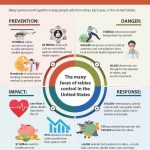
nateglinide – oral, Starlix
Medication Uses: Nateglinide is used alone or with other medications to control high blood sugar along with a proper diet and exercise program. It is used in people with type 2 diabetes. Controlling high blood sugar helps prevent kidney damage, blindness, nerve problems, loss of limbs, and sexual function problems. Proper control of diabetes may also lessen your risk of a heart attack or stroke. It works by stimulating the body to produce more insulin. Insulin is a natural substance that allows the body to properly use sugar from the diet.
HOW TO USE: Read the Patient Information leaflet if one is available from your pharmacist before you start using nateglinide and each time you get a refill. If you have any questions, consult your doctor or pharmacist. Take this medication by mouth 1-30 minutes before each main meal, usually 3 times daily, or as directed by your doctor. Take this drug no earlier than 30 minutes before the meal. Do not take a dose of medication if you are skipping that meal. If you are having liquid meals, a higher dose of this medication may be necessary to control your blood sugar. Consult your doctor for more details. The dosage is based on your medical condition, number of meals per day, and response to treatment. Use this medication regularly as directed by your doctor in order to get the most benefit from it. Carefully follow the medication treatment plan, meal plan, and exercise program your doctor has recommended. Check your blood sugar regularly as directed by your doctor. Keep track of the results, and share them with your doctor. This is very important in order to determine the correct dose. Tell your doctor if your blood sugar measurements are too high or too low. Your treatment plan may need to be changed.
SIDE EFFECTS: Weight gain may occur. If this effect persists or worsens, notify your doctor or pharmacist promptly. Nateglinide can cause low blood sugar (hypoglycemia) especially if you are taking other medicines for diabetes. Consuming large quantities of alcohol, not getting enough calories from food, or doing unusually heavy exercise may also lead to low blood sugar. Symptoms may include chills, cold sweat, dizziness, drowsiness, shaking, fast heartbeat, weakness, headache, fainting, tingling of the hands or feet, or hunger. It is a good habit to carry glucose tablets or gel to treat low blood sugar. If you don’t have these reliable forms of glucose, raise your blood sugar quickly by eating a quick source of sugar such as table sugar, honey, candy, or drinking a glass of fruit juice or non-diet soda. Check with your doctor or pharmacist to find out what you should do if you miss a meal. Symptoms of high blood sugar (hyperglycemia) include thirst, increased urination, confusion, drowsiness, flushing, rapid breathing, and fruity breath odor. If these symptoms occur, tell your doctor immediately. Your doctor may need to adjust your diabetes medication(s). A very serious allergic reaction to this drug is rare. However, seek immediate medical attention if you notice any of the following symptoms of a serious allergic reaction: rash, itching/swelling (especially of the face/tongue/throat), severe dizziness, trouble breathing. This is not a complete list of possible side effects. If you notice other effects not listed above, contact your doctor or pharmacist.
PRECAUTIONS: Before taking nateglinide, tell your doctor or pharmacist if you are allergic to it; or if you have any other allergies. This product may contain inactive ingredients, which can cause allergic reactions or other problems. Talk to your pharmacist for more details. Before using this medication, tell your doctor or pharmacist your medical history, especially of: kidney disease, liver disease, gout. You may experience blurred vision, dizziness, or drowsiness due to extremely low or high blood sugar levels. Do not drive, use machinery, or do any activity that requires alertness or clear vision until you are sure you can perform such activities safely. Limit alcohol while taking this medication because it can increase the risk of developing low blood sugar. During times of stress, such as fever, infection, injury, or surgery, it may be more difficult to control your blood sugar. Consult your doctor because increased stress may require a change in your treatment plan, medications, or blood sugar testing. During pregnancy, this medication should be used only when clearly needed. Pregnancy may cause or worsen diabetes. Discuss a plan with your doctor for managing your blood sugar while pregnant. Your doctor may change your diabetes treatment during your pregnancy. Discuss the risks and benefits of different treatments (such as diet, exercise, and medications including insulin). It is not known whether this drug passes into breast milk. Consult your doctor before breast-feeding.
DRUG INTERACTIONS: Your doctor or pharmacist may already be aware of any possible drug interactions and may be monitoring you for them. Do not start, stop, or change the dosage of any medicine before checking with your doctor or pharmacist first. Before using this medication, tell your doctor or pharmacist of all prescription and nonprescription/herbal products you may use. Many drugs can affect your blood sugar levels, making it more difficult to control your blood sugar. Examples include corticosteroids (such as prednisone), psychiatric medicines (such as olanzapine), fluoroquinolone antibiotics (such as ciprofloxacin), among others. Ask your doctor or pharmacist how often to check your blood sugar. Tell your doctor about the results and of any symptoms of high or low blood sugar. Your doctor may need to adjust your diabetes medication, exercise program, or diet. Check the labels on all your nonprescription medicines (such as cough-and-cold products) because they may contain ingredients that could affect your blood sugar. Ask your pharmacist about the safe use of those products. Beta-blocker medications (such as metoprolol, propranolol, glaucoma eye drops such as timolol) may prevent the fast/pounding heartbeat you would usually feel when your blood sugar level falls too low (hypoglycemia). Other symptoms of low blood sugar such as dizziness, hunger, or sweating are unaffected by these drugs. Other medications can affect the results of urine tests for sugar or ketones. Consult your doctor or pharmacist for more information.
QUESTION
OVERDOSE: If overdose is suspected, contact a poison control center or emergency room immediately. US residents can call their local poison control center at 1-800-222-1222. Canada residents can call a provincial poison control center. Symptoms of overdose may include: very fast heartbeat, vision changes, unexplained heavy sweating, agitation, fainting, seizures. NOTES: Do not share this medication with others. Attend a diabetes education program to learn more about diabetes and the important aspects of its treatment, including medications, diet, exercise, and getting regular eye/foot/medical exams. Learn the symptoms of high and low blood sugar and how to treat low blood sugar. Check your blood sugar levels regularly as directed. Keep all medical appointments. Laboratory and/or medical tests (such as kidney/liver function tests, fasting blood glucose, hemoglobin A1c) should be performed periodically to check for side effects and monitor your response to treatment. MISSED DOSE: If you miss a dose, skip that dose and resume your regular dosage schedule with your next meal. Do not double the dose to catch up. STORAGE: Store at room temperature at 77 degrees F (25 degrees C) away from light and moisture. Brief storage at 59-86 degrees F (15-30 degrees C) is permitted. Do not store in the bathroom. Keep all medicines away from children and pets. Do not flush medications down the toilet or pour them into a drain unless instructed to do so. Properly discard this product when it is expired or no longer needed. Consult your pharmacist or local waste disposal company for more details about how to safely discard your product. MEDICAL ALERT: Your condition can cause complications in a medical emergency. For information about enrolling in MedicAlert, call 1-888-633-4298 (US) or 1-800-668-1507 (Canada). Information last revised March 2014. Copyright(c) 2014 First Databank, Inc.
Report Problems to the Food and Drug Administration
You are encouraged to report negative side effects of prescription drugs to the FDA. Visit the FDA MedWatch website or call 1-800-FDA-1088.
Selected from data included with permission and copyrighted by First Databank, Inc. This copyrighted material has been downloaded from a licensed data provider and is not for distribution, except as may be authorized by the applicable terms of use.
CONDITIONS OF USE: The information in this database is intended to supplement, not substitute for, the expertise and judgment of healthcare professionals. The information is not intended to cover all possible uses, directions, precautions, drug interactions or adverse effects, nor should it be construed to indicate that use of particular drug is safe, appropriate or effective for you or anyone else. A healthcare professional should be consulted before taking any drug, changing any diet or commencing or discontinuing any course of treatment.


